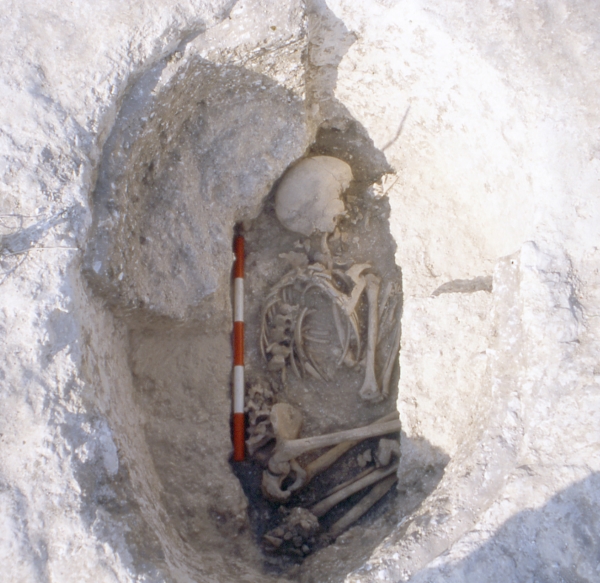
Today’s image for Day 288 of the VM_365 project shows a small oval grave that was located on the inner north west edge of a refurbished ring ditch, which was featured on Day 286 of the VM_365 project.
The skeletal remains were in a tightly crouched position, with the arms and legs flexed suggesting the body may have been tightly wrapped. The body, possibly a male aged between 14 -16 years old, had been placed on its left side, with its head facing east at the north end of the grave cut. The upper body was twisted so that the skeleton lay almost face down.
The grave cut was much smaller than the burial that was placed at the centre of the original ring ditch, measuring just 1.04 metres long by 0.7 metres wide and with a depth of 0.5 metres. There was evidence that a coffin or containing structure, perhaps a woven basket, surrounded the immediate area of the burial. A void around the skeleton had been filled by a deposit of silty clay derived from decay of organic matter and the percolation of silts from the surrounding deposits. The finer soil was retained within a chalky grave fill packed around the body, some of which is shown still in place in the picture above. The clean white chalk of the undisturbed chalk geology can be seen at the outer edge of the regular eliptical cut.
The upper fill of the oval grave pit incorporated the remains of a secondary burial, represented only by some unfused fragments of vertebrae and teeth, suggesting a juvenile. No evidence of a secondary grave cut through the fill of the earlier burial was identified during excavation. A small sherd of worn early Iron Age flint tempered pottery was found near the primary burial, but it is thought this may have intruded into the fill when the second burial was inserted in the early Iron Age.
The sequence of burial and the refurbishment of the ring ditch that defined the edge of the barrow show that once these structures were built, they were sustained as places of significance over many centuries and cultural changes. Their meaning to each successive generation may also have changed but their physical presence was a fact in the landscape which only reduced in definition and scale over a long period of time, and could when necessary, be restored to gain new importance.